

THROUGH THE AGES
Est. 1905 to Present Day

The Beginning
In 1905, Mr. Frank Jarvis and Mr. Tommy Garner formed Conway Stewart & Co. Limited at 13 Paternoster Row EC1, next to St Paul’s Cathedral in London. Today, this area is known as Paternoster Square having been redeveloped after its complete destruction during the Blitz of World War II. Although there is much debate regarding the origins of the Company’s name, it is believed that the name “Conway Stewart” derives from a popular vaudeville act of the day. Conway and Stewart were supposedly a comedy double act who appeared at Collins Music Hall in Islington. The two entrepreneur took a great risk in leaving their secured jobs to start a new enterprise reselling fountain pens made by other manufacturers. They concentrated their energies and invested in importing pens from the United States.

After an arduous month 1905 of persistent selling of their stock, they reaped the rewards of a rather healthy turnover of more than £13 and 9 shillings. This was a great accomplishment considering that the rent for their business premises was only five shillings a week. Even though this turnover would be pleasing to many new ventures, the strength of De La Rue in the fountain pen market made it impossible for the company to continue selling no-named fountain pens. In the same year, De La Rue reportedly invested £50,000 in a promotion campaign for their new launch, the Onoto. However, Garner and Jarvis soon recognized there was an audience desiring good, reliable writing instruments that were also affordable. This is when Conway Stewart began to capture a market amongst the English. Jarvis and Garner developed a single aim, to produce elegant and beautiful, yet functional writing instruments – a principle that Conway Stewart holds true to this day.

The Golden Years
The Roaring 20s was the golden age for fountain pens and Conway Stewart was suitably placed at the beating heart of this worldwide expansion.

The 1920s was an excellent decade for the courageous owners. Not only did they trademark the name of the business ‘Conway Stewart’ they also expanded their range of filling mechanisms to include eyedroppers, lever fillers, pump fillers and safeties. While the first of these pens were almost indistinguishable from others of that period, by 1925 Conway Stewart were coming into their own in terms of design.



A trademark for the name “Dinkie” was registered in 1924, along with a patent for a new locking lever mechanism. Conway Stewart was rapidly growing in popularity and demand, so much so that they were taking away market shares from other dominant pen manufacturers. Another introduction around this time was the use of brightly coloured celluloid. In the 1920s, Conway Stewart were offering dozens of different colours in their various lines, and the customer could choose from either the simple and conservative, the bright and cheerful, or the downright flamboyant.
The pens of this period were very well made, and of high quality, yet remained affordable. The wide range of models and materials allowed Conway Stewart to truly offer “something for everyone” when it came to fountain pens. This reasonable pricing and successful marketing contributed to the success of Conway Stewart for the next decade. They invested in new premises in 1927, which became their headquarters for the next two decades. As the depression of the 1930s hit, Conway Stewart was in the enviable position of marketing pens that were considered “good value”.
Although this decade proved to be a low point for Conway Stewart in terms of profit, they were able to ride out the depression successfully. Colourful plastics soon became a signature for Conway Stewart. It is interesting to note that they did not designate titles for their designs. The names we recognise today have been adopted by collectors over the years. As an example, Cracked Ice and Reversed Cracked Ice were used for many of their models for over 25 years, together with Tiger Eye, another favourite.
The Herringbone pattern and many versions of marbled colours are very popular today. Even more notable is the Number 22 Floral, with its flowered design set on a cream background. Today, over fifty years after its launch, there are still many discussions concerning the Floral. Was production limited due to the complexity of the material or was the market not ready to accept such an exotic plastic? Either way, whenever a mint No.22 Floral is found for sale today, there is always a demanding audience of pen collectors.
By the middle of the decade, Conway Stewart was ready to expand, and in 1935 they went public, with shares being offered to raise capital. Advertising campaigns managed to keep the name Conway Stewart in the forefront of the public mind, in much the same way as advertising by Sheaffer, Parker and De La Rue. The 1950s proved to be a continuation of the “golden age” for Conway Stewart, with many of their materials from this era being eagerly sought after today by collectors around the world.



Unfortunately, the 1950s also ushered in the era of injection molding for the manufacture of pens. This led to the use of solid coloured plastics in place of the wonderful patterned celluloids. By 1957, the Conway Stewart line was represented with pens that, while still very well made, and reliable writers, were not in the same league in terms of appearance. It was at this time that the first ballpoint pens were offered by Conway Stewart.

The End of an Era
The 1950s provided the last of the great Conway Stewart models. The company began to stagnate through the 1960s as the market turned relentlessly towards the disposable ballpoint. The company persevered in trying to keep up with the market trends with their ball pen and also by launching the 106, a cartridge pen mounted with a semi-hooded nib. In the 1960’s the company was sold and relocated to Wales, where the last pen rolled of their production floor in 1975.
Following a significant investment in research and development, a new era began with a focus on making pens for those who appreciate traditional craftsmanship, objects of timeless beauty and utility, and the pleasure of using a fine pen. Combined with the ever growing number of pen collectors around the world who treasured the Conway Stewart name and reputation as Britains’s greatest pen maker, makred the dawn of a new era for Conway Stewart.
The Second Golden Age
The 1990s saw Conway Stewart rise from the ashes with the launch of ‘The Gold Collection’; a range of pens made from solid gold that showcased the work of English master craftsmen in various fields including hand painting, enamelling and engraving. These fantastic pieces sold for in excess of £10,000 ($18,000), continuing Conway Stewart’s tradition of excellence in fitting tribute to the pens of earlier generations. In 1996 the Churchill model was introduced to celebrate the life of Sir Winston Churchill and his lifelong, prolific interest in writing and literature.
To celebrate the company’s centenary in 2005 the new One Hundred Series was launched, produced in various handmade resins. Accompanying the 100, the stunning Silver Duro pens arrived on the market. Made from pure English sterling silver overlaid with resin veneer, the sterling silver Duro echoes the great designs of the Edwardian era. Also launched to celebrate the 100 year anniversary of Conway Stewart were several limited editions, detailed on our limited editions page. Owners of modern Conway Stewarts are in excellent company, as Conway Stewart pens have always been the preferred choice of the most discerning and famous people from around the world and this tradition continues to this day. Her Majesty Queen Elizabeth II and The Duke of Edinburgh were presented with two Conway Stewart pens from “The Gold Collection” to commemorate their Golden Wedding Anniversary. British Prime Minister Tony Blair presented Russian President Putin with a Conway Stewart Churchill Burgundy Fountain pen on a state visit to Russia, and French President Jacques Chirac was given a Brown Marble Churchill to celebrate his 70th birthday in 2002.
Conway Stewart the chosen pen for G8 summit
Prime Minister Blair presented a Conway Stewart No 58 set to each of the G8 world leaders. President Bush and President Clinton have both owned Conway Stewart pens. Conway Stewart also created exclusive pens for many prestigious corporate and government accounts, including the Royal Air Force, the Red Arrows, Rolls Royce, Mensa, as well as numerous other high profile corporate accounts. Rick Wakeman, rock star and pen enthusiast, has a large collection of Conway Stewart pens of which he is justifiably proud.

The Conway Stewart Story continues...
In August 2014, the doors of the Conway Stewart Plymouth factory were suddenly closed when the company went into administration. Was this the end?
OUR MISSION
At Conway Stewart, we are dedicated to creating the highest quality writing instruments, blending tradition and innovation as a British manufacturer established in 1905. Our goal is to offer our customers a truly exceptional writing experience.
We are committed to upholding the values of quality, innovation, and tradition in everything we do, from the expert craftsmanship of our pens to our emphasis on excellent customer service.
We take pride in our heritage and strive to preserve and respect it in all of our products and operations.
Alastair was Managing Director of Onoto pens from 2007 until 2014 before joining Conway Stewart. He deals with all our Bespoke commissions and has worked with such famous clients as Rolls Royce, Ashmolean Museum, Churchill family, and various film producers –Kingsman; The Secret Service being one of the best known. He has a keen design eye, and loves making new pens with innovative features. All sales enquiries are directed to Alastair, and he is always keen to help however large or small the potential order.
Peter has been involved in the sub-contract manufacturing of Fine Writing Instruments for many years and was influential in the design and manufacture of the Parker Duofold range of modern classics. He brings many years of experience to Conway Stewart in manufacturing for such prestigious brands as Parker, Onoto and Montegrappa.


Ed runs the digital show and is responsible for overseeing all marketing initiatives and implementing a comprehensive strategy that promotes the brand and drives sales. The focus is on ecommerce management, digital marketing tactics, including influencer marketing. The goal is to deliver high-quality campaigns that drive sales and increase brand awareness and customer loyalty.

Jacqui has a background in financial administration and is meticulous in ensuring that work is thorough and accurate. This carries through into her product inspection, packing and distribution, where she upholds the highest standards to maintain Conway Stewart’s industry-leading reputation. Jacqui enjoys liaising with customers to ensure that products meet their needs and expectations and is, in turn, a highly valued member of the team.



Sophie has a strong academic education, with a degree in Archaeology and an MSc in GIS and Spatial Analysis. Sophie spent several years working as an archaeologist and enjoys practical work. Sophie is also a musician and trained woodwind repairer and applies these fine tool skills and attention to detail to her role at Conway Stewart where she is an expert at assembling our fine pens.
Kate is an experienced brass and woodwind instrument repairer and has worked for a variety of prestigious instrument manufacturers, demonstrating her skills in fine tool work and problem solving to create the highest quality items. Kate applies these skills in our workshop, helping to ensure that our pen mechanics are precise and reliable to an extent that can only be achieved through the hand production of every one of our Conway Stewart pens.
Conway Stewart Belliver White Whirl
Conway Stewart Belliver Classic Green



CHURCHILL COLLECTION

Conway Stewart Ashmolean Pen - John Ruskin
Conway Stewart Churchill Black Chased


Excludes VAT
Excludes VAT
Conway Stewart Churchill Blue Chased Churchill


Conway Stewart Churchill Wisteria
Conway Stewart Churchill Bordeaux Chased Churchill

Conway Stewart Churchill Bracket Brown

Churchill
Conway Stewart Churchill Bracket Green
Conway Stewart Churchill Burgundy Sterling Silver Churchill
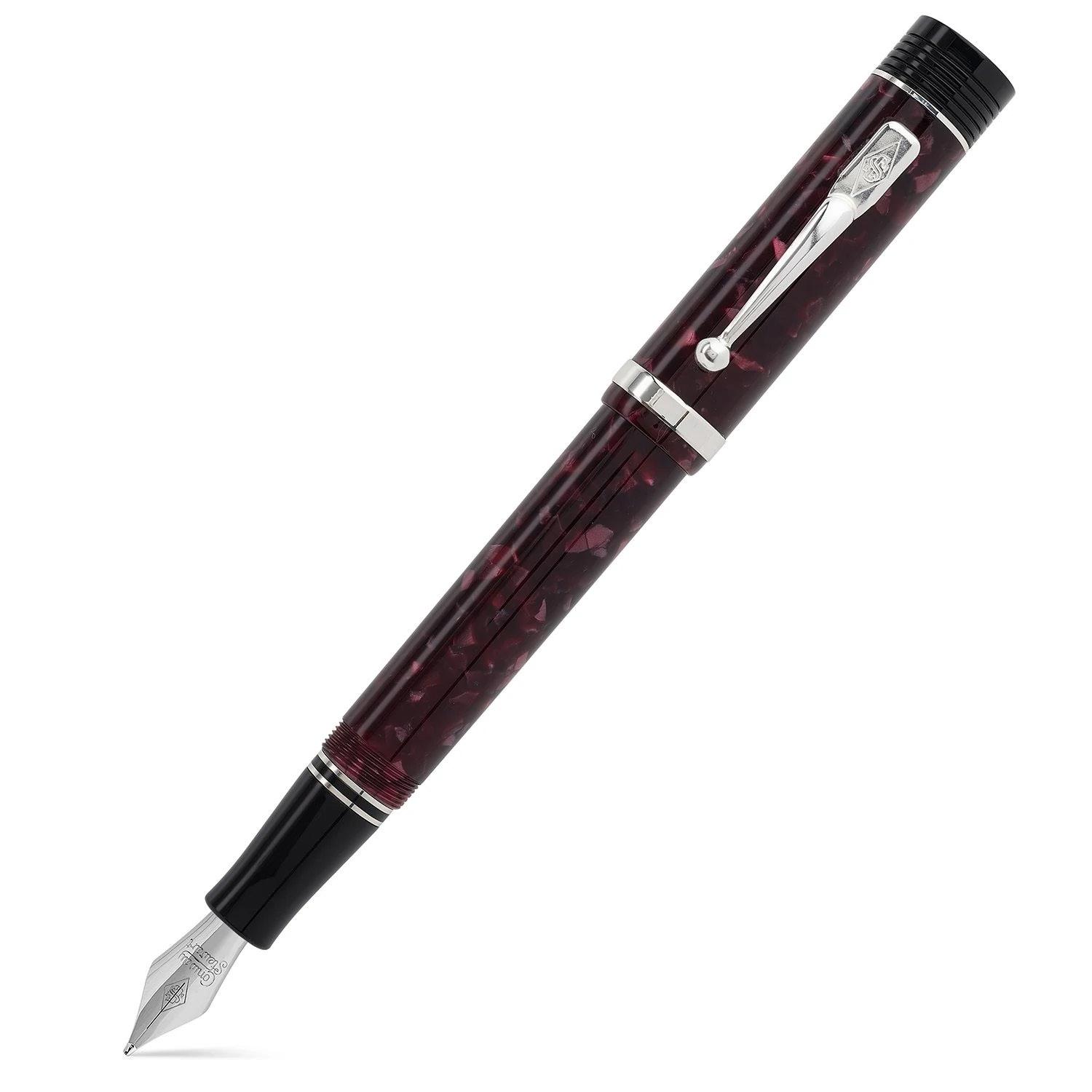
Conway Stewart Churchill Burgundy

Conway Stewart Churchill Ceruleum Blue


Churchill
Conway Stewart Churchill Classic Black Gold


From
Conway Stewart Churchill Classic Black Silver Churchill
Conway Stewart Churchill Classic Black Lever-Fill Churchill

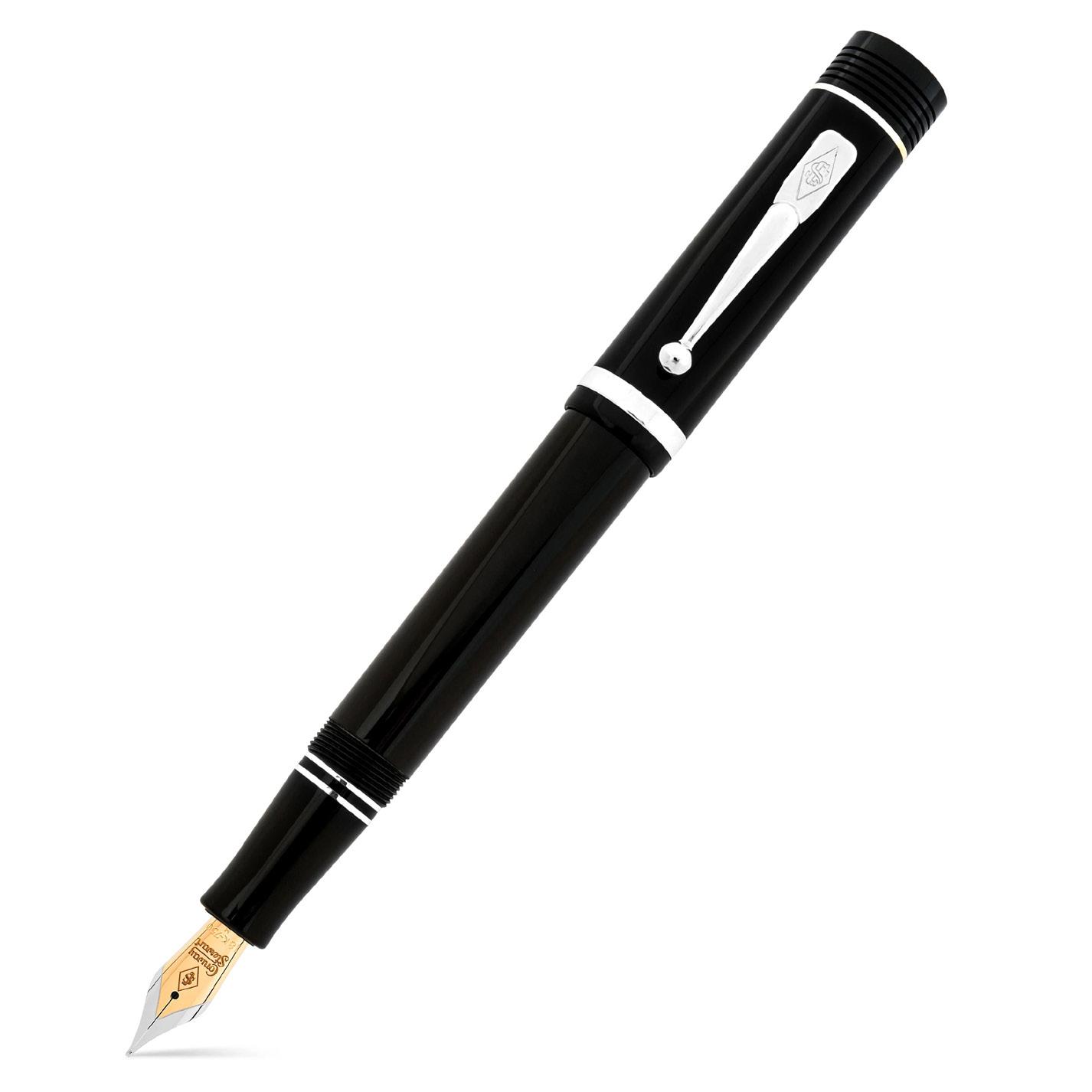
From
From
Conway Stewart Churchill Classic Brown Lever-Fill
From
Conway Stewart Churchill Classic Green Lever-Fill Churchill

Conway Stewart Churchill Demo
Churchill
Conway Stewart Churchill Fresian
Conway Stewart Churchill Honey Noire Lever-Fill



Churchill
Conway Stewart Churchill Honey Noire
Churchill
Conway Stewart Churchill Lawyer’s Pen
Conway Stewart Churchill Modena Red

Churchill 440.00


Conway Stewart Churchill Peppered White

Conway Stewart Churchill Quartz White Churchill



Conway Stewart Churchill Red Stardust

Conway Stewart Churchill Evergreen
Conway Stewart Churchill Shingle



CHURCHILL HERITAGE



Price Excludes VAT
Conway Stewart Churchill Heritage ‘Victory At All Costs’
Excludes VAT













b. July 1952 – d. June 2020
Henry Simpole
Henry was one of the most famous and admired British designers of overlay pens. As a silversmith he had a global reputation and in 2004 he started his association with Conway Stewart by designing the Centenary Pen. The design cleverly incorporated the “C” and “S” of Conway Stewart and their founding year “1905” but you have to look closely to see them. This became one of Henry’s trademarks, hidden letters and numbers in complicated and beautiful filigree work. Henry went on to design and make many more pens for Conway Stewart which were sold around the world. His overlay and are now prized by pen collectors. Henry designed and made the following Conway Stewart pens:
1. The Conway Stewart Centenary pen - Limited edition of 100 in sterling Silver & 100 in Vermeil
2. The Conway Stewart ‘Henry Simpole’ pen - Limited edition of 50 in sterling Silver & 50 in Vermeil & 25 in 18ct Gold
3. The Conway Stewart Exhibition ‘Giant’ Pen - Limited edition of 100 in sterling Silver & 100 in Vermeil
4. The Conway Stewart Chatsworth - Limited edition of 100 in sterling Silver & 50 in Vermeil & 25 in 18ct Gold
5. The Conway Stewart Marilyn Monroe Pen - Limited edition of 90 in sterling Silver


We are now able to offer a very limited number of Conway Stewart pens made by Henry, and bought from his estate. All are originals and numbered. Henry kept a number of pens in each edition for his own collection and for sale.

Conway Stewart Marlborough Vintage Black Ebonite Silver

Marlborough
Conway Stewart Marlborough Classic Green
Conway Stewart Marlborough Vintage Woodgrain

Conway Stewart Marlborough Vintage Black Ebonite Gold Marlborough


495.00
Price Excludes VAT
PEAKY BLINDERS COLLECTION

BY ORDER OF THE PEAKY BLINDERS
With the 6th series of the hugely successful ‘Peaky Blinders’ TV series hitting the British screens at the end of February 2022, Conway Stewart was asked to launch a collection of limited edition pens based on the leading character; Tommy , Arthur and Polly.
In 1919 when the story of the Shelby family begins, fountain pens were becoming more and more popular worldwide, and an important industry in the city of Birmingham where the Peaky Blinders series is based. It has been estimated that approximately 75% of the world’s annual production of pen nibs were manufactured in Birmingham from the late 19th century to the early 20th century. Today the Birmingham Pen Museum, in the Jewellery Quarter, is proud testament to the long history of pen and nib making in the industrial heartlands of Great Britain.


One of the most famous Conway Stewart pens today is named after Winston Churchill. Fans of the Peaky Blinders will know, Winston plays an important part in Tommy Shelby’s life. In fact the actual pen used by Tommy Shelby in the series looks very much like the Churchill Classic Black Silver on which this Limited Edition Thomas Shelby Pen is based.



Conway Stewart Churchill Lawyer’s Pen
Conway Stewart Series 100 COMMANDER
Conway Stewart Series 100 Lawyer’s Pen




SERIES 58
Conway Stewart Series 58 Amber
£
330.00
Price Excludes VAT
Conway Stewart Series 58 Burgundy

Conway Stewart Series 58 Classic Black Gold


From £
330.00
Price Excludes VAT
From £
330.00
Price Excludes VAT
Conway Stewart Series 58 Classic Black Silver


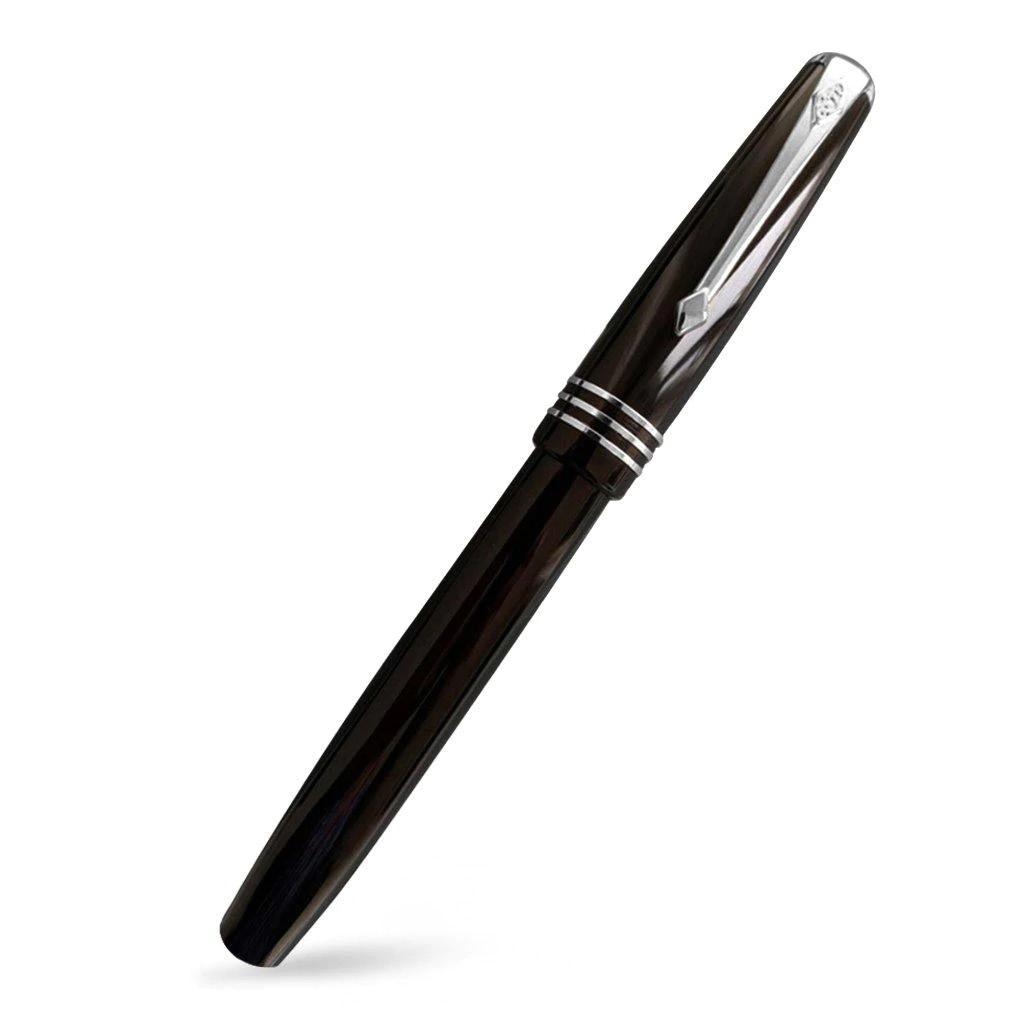
Conway Stewart Series 58 Fresian
Conway Stewart Series 58 Nebula
Conway Stewart Series 58 Seamus Heaney

Conway







Conway Stewart Series 100 Meteor
Conway Stewart Series 100 Nebula


Conway Stewart Series 100 Shingle



















Conway Stewart Winston Cherry Red

Conway Stewart Winston Classic Black Gold



Conway Stewart Winston Classic Black Silver
Conway Stewart Winston Classic Brown









Ballpoint Refills (Pack of 3)

Accessories Ink 5.00 £
Bespoke British Leather Wallet with a Smart Tag Bluetooth Tracker
Accessories Blotters


Blotting Paper (Pack of 8)
7.00 £
Excludes VAT
Accessories Nibs

Calligraphy Nibs
65.00 £ Price Excludes VAT
Accessories Ink
Conway Stewart Fountain Pen Ink Cartridges (Pack of 6)

Accessories Ink
Conway Stewart Fountain Pen Ink

AVAILABLE IN
Aqua Blue
Onyx Black
Blue/Black
Sherwood Green
Saddle Brown
Imperial Purple
Poppy Red Sapphire Blue
Accessories Gift Cards
Conway Stewart Gift Card £100

4.00 £ Price Excludes VAT
Accessories Gift Cards
Conway Stewart Gift Card £250

8.00 £ Price Excludes VAT
100.00 £ Price Excludes VAT
250.00 £
Price Excludes VAT
Accessories Gift Cards
Conway Stewart Gift Card £500

500.00 £ Price Excludes VAT
Accessories Gift Cards
Conway Stewart Gift Card £1000

1000.00 £ Price Excludes VAT
Accessories Blotters
Conway Stewart Traditional Desk Blotter - Full Demy - largest size


Accessories Blotters
Conway Stewart Traditional Desk Blotter - Half Demy - smallest size
70.00 £
Price Excludes VAT
55.00 £
Price Excludes VAT
Accessories Blotters
Conway Stewart Walnut Desk Tray with Sterling Silver Insert
Accessories Ink
FineLiner Refills (Pack of 2)

Accessories Ink


Flag Fountain Pen Ink
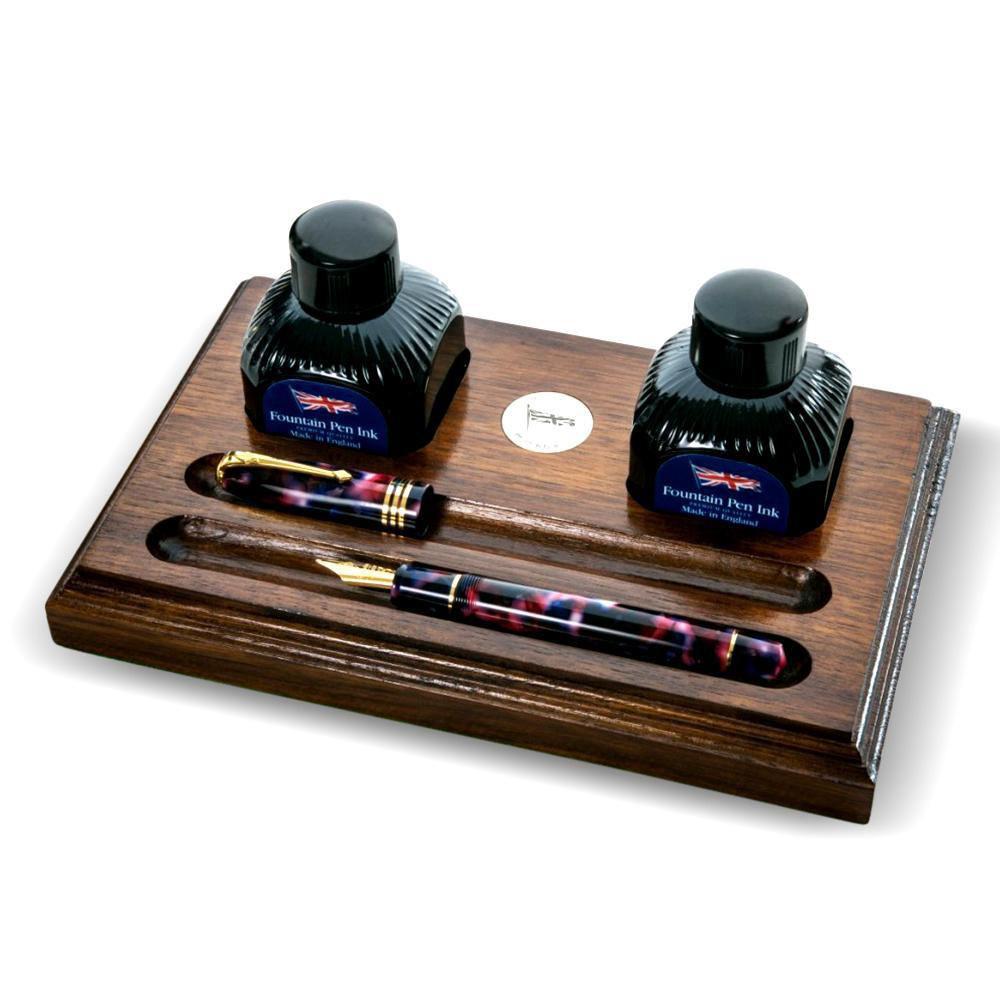
99.00 £ Price Excludes VAT
10.00 £
Price Excludes VAT
Accessories Blotters
Flag Walnut Desk Tray with Sterling Silver Insert
AVAILABLE IN
Aqua Blue
Onyx Black Blue/Black
Sherwood Green
Saddle Brown
Imperial Purple
Poppy Red
Sapphire Blue
8.00 £ Price Excludes VAT
99.00 £
Price Excludes VAT
Accessories Books
Fountain Pens for the Million Conway Stewart

Accessories Pen Cases
Leather 2-pen case with 23ct Gold Plated Fittings


110.00 £
Price Excludes VAT
Accessories Ink 5.00
Lead Refills (Pack of 10)

Accessories Pen Cases
Leather 2-pen case with Sterling Silver fittings
99.00 £
Price Excludes VAT
Paper refills for the Conway Stewart Traditional Desk Blotter Accessories


Pen Polishing Cloths (Pack of 2)
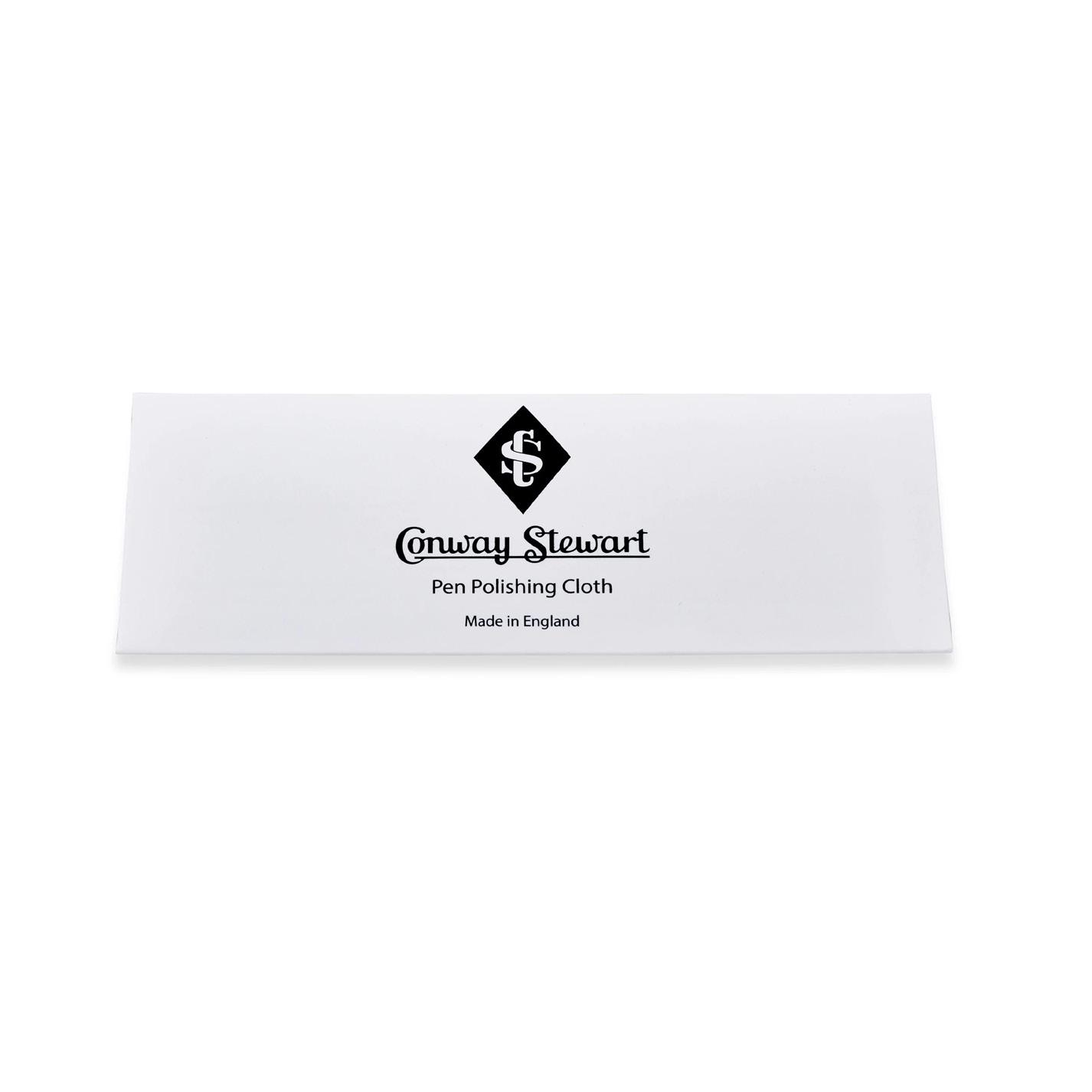
Rollerball Refills (Pack of 5)

Accessories Ink
Screw-in K6 Ink Converter

10.00 £
Price Excludes VAT
Accessories Blotters
Silver Plated Pewter Dragonfly Blotter with Mahogany Wood
Accessories Pen Cases

Single Pen Case with Sterling Silver fittings


65.00 £
Price Excludes VAT
60.00 £
Price Excludes VAT
Accessories Books
The Swan Pen, Mabie Todd in England 1880 – 1960
55.00 £
Price Excludes VAT
Conway Stewart Christmas 2022 Shimmer Ink
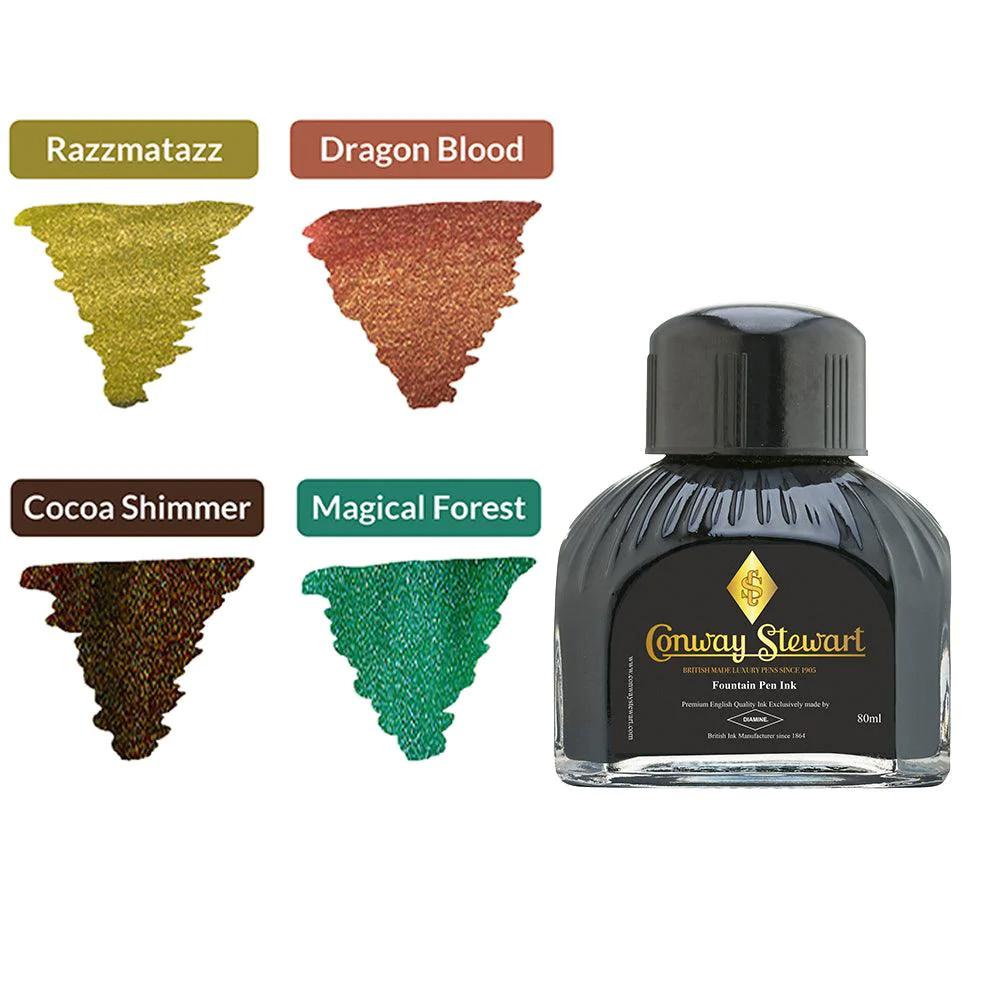

Conway Stewart Luxury Notebook


Sir Winston Churchill once said “I have always earned my living by my pen” so you won’t be surprised to discover that the great man had an affinity for British pens and especially those manufactured by Conway Stewart.
Conway Stewart History
Formed in London in 1905 by Frank Jarvis and Howard Garner, Conway Stewart initially sold pens manufactured by others including some imported from the USA. But it wasn’t long before they started manufacturing their own range of top quality British fountain pens with distinctive designs – and have continued doing so until the present day – admittedly with a few breaks!
During the Second World War, the London factory was nearly destroyed in The Blitz, but the company managed to keep manufacturing. The 1950s were an exciting time with many new designs including the Series 58 and Series 100 (still available today) helping the company to celebrate record sales.
The enduring links between Sir Winston Churchill and Conway Stewart
As a war correspondent in the battlefields of North West India, Sudan and South Africa, a reliable fountain pen was his essential ‘tool of trade’. Yet in those early days before the start of the 20th century, pens with steel nibs and a bottle of ink would have been his only resource. It wasn’t until the early 1900s that the first self-filling pens appeared and one of the first companies to take advantage of this new form of writing implement was Conway Stewart.
Churchill as an Author

After the stresses and strains of the Second World War, the great man concentrated more on his career as a writer and settled into a formidable routine at Chartwell, the country house in Kent he had bought in 1922.
He wrote ‘The Second World War’ a mammoth 6-volume account of the war which became a world-wide best-seller. As a celebrated author and journalist he was awarded the Nobel Prize for Literature in 1953. You may be surprised to know that in his lifetime Churchill wrote more words than Dickens and Shakespeare added together!
if you are wondering how much Conway Stewart pens played in this mammoth task, it’s impossible to say. But a couple of facts are indisputable. Firstly, if you visit Chartwell today and look at Churchill’s study, laid out as it was during World War II, you will find 2x Conway Stewart pens on his desk – see photo of one of
ently, Churchill had requested the pens from his regular pen retailer who advised that they were out of stock and no longer being made. A few telephone calls later and Conway Stewart confirmed that they would make the pens specially for Sir Winston Churchill! Outstanding customer service – as always!


Churchill’s Legacy at Conway Stewart
In the 1990s Conway Stewart recognised Churchill’s dedication to their fountain pens by naming two new designs, The Winston and The Churchill, after him and these remain two of the most popular pens today.
Fast forward to 2018 and the ‘special relationship’ developed even further with the launch of the new Churchill Heritage range. Produced in association with Churchill Heritage, an organisation through which the Churchill family distributes money to charities and good causes which keep alive Sir Winston’s legacy and the spirit of the words of wisdom he penned.

The Churchill Heritage range consists of six magnificent pens limited to 100 editions, each one bearing one of Churchill’s famous quotes engraved on the barrel together with a facsimile of the Great Man’s signature and ‘Made in Great Britain’.
There were 6 editions in the collection the first 2 have now sold out:
Engraved on the top of the cap of all the Heritage pens is the iconic sketch of “Pug” that Sir Winston Churchill penned on a letter to his wife Clementine dated 1st August 1909. Clementine called Winston “my sweet pug” and in turn he often drew little animated pictures of “pug” at the bottom of his letters to her.
Throughout its history, Conway Stewart pens have found their way into the hands of presidents, prime ministers and royalty –so you know you’re in good company when you use one, and you can be sure that every aspect of the Churchill Heritage pen conforms to those elements of heritage, tradition and quality which have underpinned the brand for more than 100 years.
What do the hallmarks mean on your Conway Stewart fountain pen?
A question that we are frequently asked about our pens is what the little marks - known as hallmarks - on any silver or gold parts mean. So we thought it would be helpful to explain the history and development of this important element of British law.
British hallmarks have developed over the course of the last 800 years so that today’s hallmarks provide a comprehensive identifier and consumer guarantee of purity on every item on which they are stamped. For example, here’s what you might find on the cap band or other precious metal part of your Conway Stewart fountain pen today:

More than 800 years ago, in what was probably the earliest form of consumer protection, King John, who reigned in England between 1199 and 1216, decided that precious metals – mostly silver and gold coins at that time – should have a guaranteed and fixed precious metal content. For silver the standard was set at 92.5% with the balance of 7.5% made from copper. Today, this percentage is still confirmed by a Fineness Mark stamped on each piece of sterling silver by the Assay Office which confirms that there are 925 parts per thousand of pure silver.

In 1238, King Henry III proposed that the Guild of Goldsmiths should appoint six of their most worthy goldsmiths to monitor the craft of silver and gold manufacture to try to ensure that the metal content of silver and gold items was being adhered to across the UK.
Hallmarking was first established in the 12th century and has been used ever since to confirm the quality and purity of precious metals such as gold, silver and platinum. A system of marking such items was necessary because the pure metals are too soft to be used to make jewellery or silverware so they need to be mixed (alloyed) with copper or other metals to give them the strength needed to maintain their shape and durability. This mixing of alloys with precious metal gave unscrupulous manufacturers the opportunity to ‘cheat’ the purchaser by adding more alloy to the mix!
The Standard or Sterling Mark (Lion Passant)
The Assay Mark
It was a difficult task which could never be fully policed. However, in 1300 King Edward 1 grasped the nettle and made a law that no gold or silver could be sold until it had been taken to the Guild of Goldsmiths to be tested. If approved, the article would be impressed with a small mark to show that it had been tested and was of the correct quality. The image selected for what was initially known as ‘The King’s Mark’ was that of a lion’s head but it looked more like a leopard so soon became known as the Leopard’s Head mark.
In 1544 the Leopard’s Head mark was superseded by the Lion Passant mark in the form of a lion in full profile, as if walking to the left with its right front paw raised. This mark eventually became known as the Sterling Mark and is used on all sterling silver items today.
The Maker’s Mark
The next step in the regulation of the gold and silver manufacturing processes came in 1363 when King Edward III decided that every goldsmith or silversmith should have a personal ‘mark’ so every piece could be traced back to a specific manufacturer. Many early ‘makers marks’ took note of the fact that very few people at that time could read, so they were designed not as letters but as emblems which could be ‘translated’ into the relevant name. For example, John Rose would have an image of a flower, Tom Farmer would have a sheaf of corn etc. But over the years, as education standards improved, letters became more prevalent as an identifier of the manufacturer so that, for example, ‘CS’ is the current Conway Stewart identifier or maker’s mark.
With more and more silver and gold items being manufactured from the 15th century onwards, the testing processes (or assai meaning ‘examination’ in French) was being undertaken in several English cities. Bristol, Birmingham, Chester, Coventry, Exeter, Lincoln, London, Newcastle, Salisbury, Sheffield and York all had their own Assay offices at various times, enabling silversmiths to have their products tested locally.
Today, there are Assay Offices in London (represented by a Leopard Head mark), Birmingham (Anchor), Edinburgh (Castle) and Sheffield (Rose). The Birmingham Assay Office was opened in 1773 and today is one of the busiest Assay Offices in the world.
The majority of Conway Stewart components are assayed at the Birmingham Assay Office.
The Date Mark
The Date Mark was determined as a single alphabetic character for each calendar year with different fonts being used every 20 years or so. In retrospect it would have been much simpler if all Assay Offices had used the same letter and font each year but that wasn’t to be the case, so checking the original manufacturing date of any item of silver can be a lengthy process.
Since 1975, however, all hallmarking date marks have been consolidated, so that all Assay offices use the same date letter which changes on 1st January each year. The last few years have been as follows:
Commemorative marks
Occasionally, special marks may be added to the range of hallmarks found on items of silver or gold. In recent times there have been additional marks to commemorate The Queen’s Silver Jubilee (1977), the Millennium (2000), The Queen’s Golden Jubilee (2002), The Queen’s Diamond Jubilee (2012) and this year The Queen’s Platinum Jubilee. This latest mark may be stamped on any precious metal issued up to the end of 2022. Conway Stewart used this commemorative mark on their Limited Edition pen to celebrate the Queen’s Platinum Jubilee. All 70 of the Sterling Silver pens have been sold. At the time of writing this article we have 3 platinum editions remaining of the Queen’s Platinum Jubilee collection.
Punishable by death
In 1757 counterfeiting hallmarks became a felony, punishable by death. This later changed to transportation to a penal colony. In England it is still a punishable offence (Hallmarking Act 1973) to offer for sale any article purporting to be made of a precious metal unless it bears the official hallmark stamp of one of the recognized Assay Offices. Today, the maximum penalty for counterfeiting a British Hallmark is 10 years imprisonment.
Your guarantee of quality and purity
So those little marks on your Conway Stewart pen and accessories have a lot of history, and give you the assurance that the precious metals used on our pens and accessories are genuine. British hallmarks are a guarantee of quality and purity that’s recognised and valued everywhere around the world.
We hope this has given you an insight into the history and development of British hallmarking and helped you understand what each of the hallmarks on your pens means.
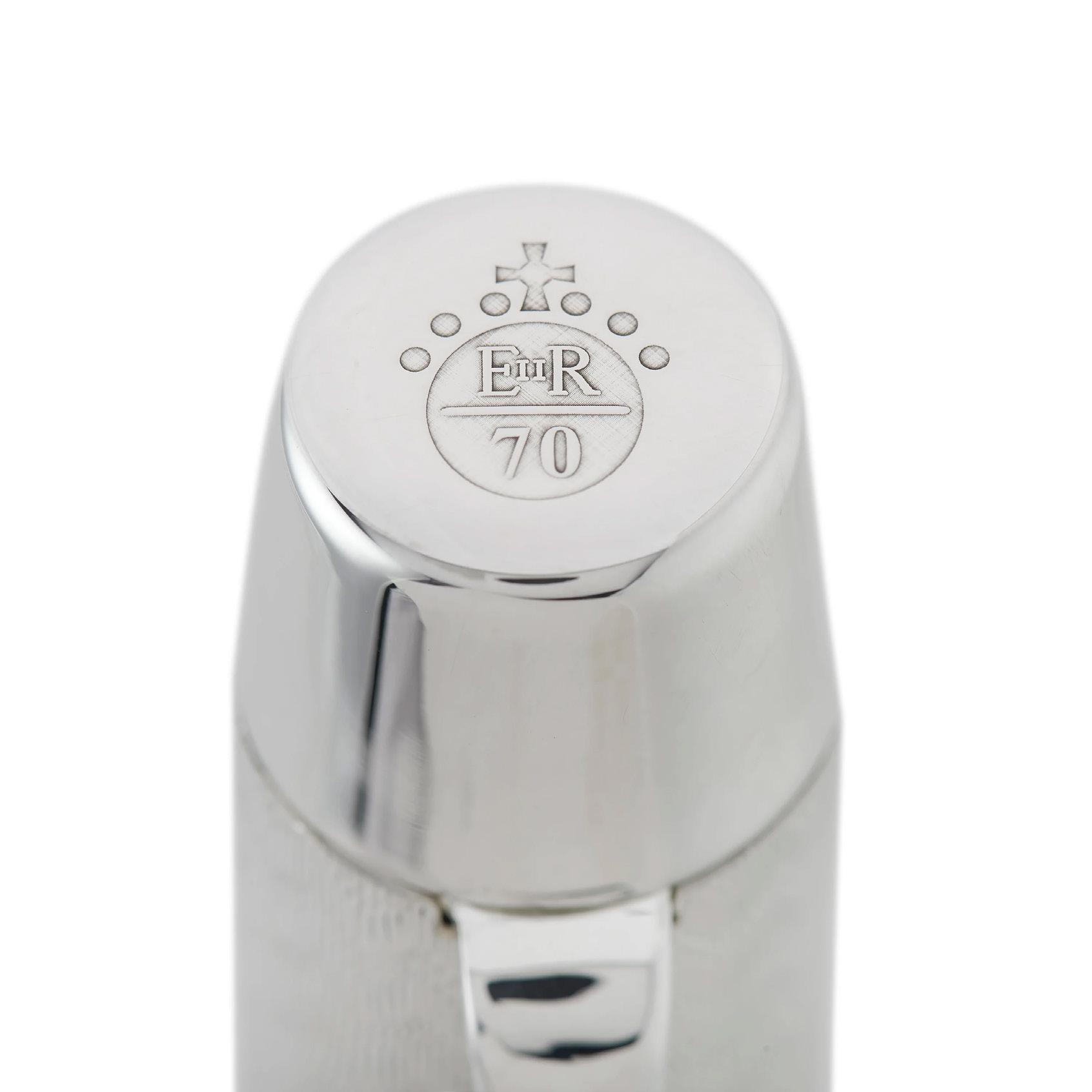
Bespoke British Pens Ltd
Unit 11C, The Wren Centre Westbourne Road
Emsworth
Hampshire
PO10 7SU
United Kingdom
Tel +44 1243 278916 conwaystewart.com
Inkwell London
Please phone to make an appointment to see Francis at Inkwell
United Kingdom
Tel: +44 7785 575057 Inkwell-pens.com
Howards Jewellers
43A Wood St
Stratford-upon-Avon
CV37 6JG
United Kingdom
Tel: +44 1789 205404 howardsjewellers.com
PenFriend
PO Box 119, 8 Duncan Street
London
N1 8BW
United Kingdom
Please phone to make an appointment to see Penfriend
Tel: +44 20 7499 6337 penfriend.co.uk
The Writing Desk
53 Horsecroft Rd Bury St Edmunds IP33 2DT United Kingdom
Tel: +44 1284 771454 thewritingdesk.co.uk
Write Here 10 High St Shrewsbury
SY1 1SP
United Kingdom






Tel: +44 1743 245950 writeherekitenow.co.uk
Zaf Pens
Patroklou 77 Athens
1312
Greece

Tel: +30 2102618156 zafpens.com
Papelería Ferrer
Calle Sierpes, 5, Sevilla 41004
Spain

Tel: +34 954 22 64 14 stilographcorsani.com
Stilograph Corsani
Roma Via Ottaviano, 79 Roma RM 00192
Italy

Tel: +39 06 3972 3284 stilographcorsani.com
The Old Bookshop
The Old Bookstore. Hafnarstræti 3 425 Flateyri Iceland
Tel: +354 8400600 gamlabokabudin.is
Vaness Inc.
5320 South Shackleford Road Suite F Little Rock AR 72204 USA

Tel: +1 501-353-2362 vanness1938.com
Inkt
17 Victoria Ave Whanganui
Manawatu-Wanganui 4500
New Zealand inkt.co.nz


The Imperial Quill Sector 89, Gurugram, Haryana 122004
India theimperialquill.com

PenGallery
60A, 1st Floor, Jalan SS 2/72, SS 2 Petaling Jaya, Selangor 47300
Malaysia

Tel: +60 3-7956 3318 pengallery.com.my
PenStory
Convensia-daero 42beon-gil, Songdo-dong, Yeonsu-gu, Incheon, South Korea

Tel: +82-10-4451-8845
PenStoryShop.com
Delivery, Taxes & Customs
All pens are made to order
Please allow up to 28 days from order date to shipping. However, we understand that at times there are urgent requirements for a birthday, retirement gift or special day, so we do have a PRIORITY PRODUCTION fast track service. To use the service, simply lets us know the date you need the pen by writing the date in the comments box at check-out. We will then do our best to get it to you by that date.
On orders for accessories please allow 2 - 8 days from order date to shipping.
We tend to use Royal Mail for all deliveries unless DHL Courier service is chosen at check out. There is an additional charge for using DHL.
UK Deliveries
For delivery to UK addresses we use Royal Mail Special Delivery, which guarantees delivery before 1pm the following day after despatch (Monday to Friday). You will normally need to sign for your parcel on receipt, although during COVID, the postmen have been taking photographs instead.
International Deliveries
For delivery to overseas addresses we use Royal Mail’s International Tracked & Signed service. Once the parcel arrives in your country, your local postal service takes over responsibility for delivery, although you can still use Royal Mail’s ‘Track and Trace’ system. You will normally need to sign for your parcel on receipt.
In some countries, you can use the Royal Mail tracking number we provide on your local postal service website. For example you can use Royal Mail Tracking numbers on the USPS website to track your parcel in the USA. In other countries you will need to check with your local postal service to see if they can track international parcels in this way.
VAT – Purchase Tax
All goods shipped to an address in the UK will be charged VAT. All goods shipped outside the UK will not be charged VAT.
Custom Duty
Some countries will charge customs duty and/or tax on any item imported, often dependent on the value of the goods. Such charges are the responsibility of the purchaser to pay.
Repair Service
IN THE UNITED KINGDOM
Eric Wilson 44/2 Belmont Road
Juniper Green
Edinburgh EH14 5DY
Tel: +44 (0)7977 559 646
IN THE USA
Vanness Pen Shop, Little Rock, AR 11610 Pleasant Ridge Road, Suite 106
Pleasant Ridge Town Center Little Rock AR 72223
Tel: +1 501-353-2362
IN AUSTRALIA
The Pensmith P.O. Box 177 Berwick 3806
Victoria
Tel: +61 407 377 160
Conway Stewart Workshop
We are offering factory-based repairs for modern Conway Stewart pens.
- Nib repair
- Cap service or replacementInk filler service or replacement
- General maintenance
Please get in touch with the form below if you have an enquiry concerning a repair to a modern Conway Stewart pen ie a pen made after 1990.
100% Satisfaction Guarantee
Guarantee
All our pens are manufactured in the United Kingdom to the highest standards of quality and workmanship, and each carries a 12-month guarantee against defect or fault.
The guarantee does not cover damage caused through misuse, negligent handling or improper treatment of the pen. In the event of the need to use this guarantee, please contact our workshop and explain the issue.
We will repair any defect free of charge, or replace the pen with a new pen of the same value. Please empty all ink from any fountain pens before returning.
Nib Exchanges
If you buy a pen from our website and find that the nib is not the correct size for your writing we will change it for you free of charge (subject to availability).
Please inform us within 14 days to arrange to return the pen or nib to us for exchange for another of the same value.
We can extend this period on request for pens bought as gifts. Note that nibs will only be exchanged if returned in as-new condition, and cleaned.
100% Satisfaction Guarantee
If you are not 100% happy with your pen, then you can return it to us within 30 days of receipt for a full refund. Goods must be returned in their original packaging complete with all labels and instructions and in the case of fountain pens, in un-filled condition.
If you are unsure about a pen at first sight, please just dip test it first using washable blue ink, just as you would do in a traditional shop. We reserve the right to reduce the refund if a pen has been mishandled.
Where do I send my goods?
Please contact us first and explain the issue before returning any pen or nib so we can make any necessary arrangements. Our workshop address is:
Conway Stewart / Bespoke British Pens Limited
Unit 11C
The Wren Centre
Westbourne Road
Emsworth
Hampshire
PO10 7SU
United Kingdom
We recommend that you send all items by Signed for Delivery (for example Royal Mail Special Delivery in the UK ) or other tracked method as we cannot be held responsible for goods that don’t arrive.
Please note we cannot accept returns of bottled fountain pen ink once opened. This does not affect your statutory rights.
Make sure you include a note so we know who it’s from, giving your name, telephone number and email address.
Caring for my fountain pen
How do I clean my fountain pen?
Dirt and grease in the atmosphere and on your hands mean that your pen will become dirty over a period of time. A build up of grease on the nib and feeder may also prevent the ink from flowing properly. That’s why we recommend cleaning your fountain pen three or four times a year. To keep the ink flowing simply flush out the filler mechanism, nib and feeder system with tepid water until the liquid runs clear, then dry gently. Holding a lint free cloth against the nib slit will help draw excess water out of the feeder system. Do not use detergents, solvents or hot water as this may damage the mechanism or finish. Do not put the whole pen under water as this will damage some filler mechanisms.
Flushing and cleaning the system in this manner should be done each time you change ink colour.
Ink soiling the interior of caps can be cleaned with a piece of damp paper tissue rolled around the inside of the cap. Alternatively a damp cotton bud may be used.
The exterior acrylic finishes may be cleaned by rubbing gently with the Pen Polishing Cloth which now accompanies each pen purchased. The cleaning cloths are also available to purchase from the Accessories page. The cleaning cloth is impregnated with a cleaner and anti-tarnishing agent so it’s ideal for giving gold or silver fittings that ‘just-out-of-the-box’ sparkle!
How do I look after my fountain pen nib?
The nib of a fountain pen imparts the quality of the writing experience and over time takes on the personality of its user’s handwriting. All the fountain pens included on this website are fitted with very high quality nibs with an iridium tip. This tip protects the nib and governs the width of the pen stroke.
Most Conway Stewart pens are available with a choice of Extra Fine, Fine, Medium or Broad. Customised nibs – italic, stub, oblique etc – are available to order for a small additional fee. The full range of nib availability is indicated on each product page.
The choice of nib is a very personal one but as a general guide – smaller, lighter and precise handwriting would err towards a finer nib and larger, more generous and flamboyant handwriting towards a broader nib. Most users decide that a medium nib offers the best of both worlds.
We ensure that our nibs are carefully fitted, aligned and polished during assembly of your pen to ensure a very high quality mark during use. It is good practice to place the cap onto a fountain pen in the upright position. If you drop the pen downwards into the cap ink spots can be deposited from the nib onto the interior surfaces of the cap.
How should I hold my fountain pen?
This is a very personal thing and should simply be at a comfortable angle for your writing style. Ideally the nib should receive even pressure on each half to avoid the risk of splitting the nib. Over a short period of time the malleable properties of the nib will allow it to contour to your writing style.
As the nib will be personalised by your handwriting it is best used only by one person. If you wish to gift your pen to someone we recommend you have a new nib fitted.
Is there a User Guide?
All Conway Stewart writing instruments are designed to give you a high quality writing experience for many years. Each pen is supplied with a comprehensive User Guide that explains how to look after your pen, and how to fill it with ink. If you have any further questions about your pen, please contact us.
Which inks can I use for my fountain pen?
We recommend that you use only quality inks, such as those available to purchase from our Accessories page, to ensure a quality writing experience. We recommend the use of ink that is less than a year old as residues may become a problem with inks that have been stored for lengthy periods.
What is best for left-handed writers?
Left-handed writers use so many different writing styles; overwriting and underwriting, writing uphill, writing horizontally, and writing downhill, that it’s not really possible to recommend any one nib. Experimentation on what works for you is the only answer!
Understanding Writing Modes
How do Conway Stewart line widths compare to Japanese line widths?
Please see below diagram.
STROKE WIDTH CHART FOR FOUNTAIN PENS
Notes:
1. All measurements were made with a 50X microscope (metric reticle, line spacing 0.02 mm).
2. The Stroke Sample set was generated with a computer to give you a very accurate metric against which you can measure the strokes of the pens you’re evaluating.
3. Because no paper is perfectly smooth, parts of any stroke made with a real pen may be broader or narrower than the precise measurement. The measurements in this chart represent slow strokes drawn by nibs. A rapid stroke will typically be narrower than the width illustrated. Out of the box, many nibs are set too dry and will write narrower than shown here — but they may be prone to skipping or have starting problems. Different inks, different flow rates, and different papers will produce different results. Even temperature, humidity, and barometric pressure can affect a fountain pen’s performance. You should not expect your testing to duplicate exactly the measurements shown here.
4. Measurements for the example metric gel pens shown here were taken with the pens used lightly, as a fountain pen user might use them. Pressing harder will produce a stroke 0.2 to 0.3 mm wider than shown in the chart. Manufacturers’ measurements for these pens represent the physical sizes of the pens’ tips, not their stroke widths.
Special Nib Options: What are the 3 basic nib shapes or styles?
Round Nibs:
A round nib is ground and polished to have roughly a circular footprint, so that its line width is fairly uniform no matter what direction the nib is moving across the paper. Here is a magnified silhouette representing the basic shape of a round nib, together with a cross illustrating the uniform stroke width that this nib produces. All of our standard nibs are Round Nibs.
Stub Nibs:

A stub nib is elongated sideways, to have a footprint that is somewhat elliptical. This makes it lay down a slightly broader line when moving up and down (in relation to the nib itself) and a narrower one when moving sideways (again, in relation to the nib). The wider line is between 1.5 – 2.5 times thicker than the thinner line in our custom ground stub nib. The eccentricity of the ellipse isn’t too pronounced, and the nib is still polished to have nice rounded edges. This means that you can write with a stub just about as easily as with a standard nib. Here is a magnified silhouette representing the basic shape of a stub nib, together with a cross illustrating the slight variation in stroke width that this nib produces.
Italic Nibs:
An italic nib is far more elongated. This makes the difference between its broad (up-anddown) strokes and its narrow strokes (sideways) more pronounced than with a stub.A traditional italic nib has a perceptible straight edge across the tip, and relatively less rounding to the edges than a stub nib. This results in a greater tendency to catch on corners and to skip if the nib is not held straight-on to the paper. This can make the nib feel “scratchy”. However, there is a compromise grind called cursive italic, which has more rounded edges than a traditional italic. When properly ground and finished, a cursive italic nib can produce stroke variation almost as strong as an italic nib while the writing feel is nearly as smooth as a stub of similar width. All our custom ground italic nibs are cursive italics unless otherwise requested.
What
is a rollerball?
A rollerball is like a biro/ballpoint but has the free-flowing ink qualities of a fountain pen. Beautiful to write with, yet with the convenience of a ball-point.
What
are Calligraphy nibs?
Calligraphy nibs have the same shape as italic nibs (i.e. elongated), but might be even wider, and are finished with squarer edges. This square-edged grind and the wider footprint result in a greater tendency to catch on corners and a greater tendency to skip if the nib isn’t held straight-on to the paper (i.e. when one side of the nib lifts away due to the nib’s being rocked sideways). Writing too rapidly with a calligraphy nib tends to produce scratchiness and skips. However, by writing more slowly, calligraphy nibs give a very crisp and controllable line width, and with practice, some writers become very proficient with calligraphy nibs, producing beautiful text. We can grind specialist calligraphy nibs on request.











WRITING MODES WRITING MODES
WHAT ARE OBLIQUE NIBS?


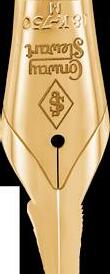





An oblique is ground so that the writing tip contacts the properly when the pen is rotated in the user’s hand. This suits some handwriting better.
WHAT IS BEST FOR LEFT-HANDED WRITERS?
Left-handed writers use so many different writing styles, overwriting and underwriting, writing uphill, writing horizontally, and writing downhill, that it’s not really possible to recommend any one nib. Experimentation on what works for you is the only answer! However, the traditional thinking is a Left Oblique is more suited for a right-handed person, and a Right Oblique is more suited to a left-handed person.
Conway Stewart Related Questions
Can I see a comparison of the Conway Stewart models?



